NASA's GMAO Makes A Strong Presence at AGU Fall 2016 Meeting
01.18.2017

Reported by Clara Orbe, Manuela Girotto, and Tom Oda
NASA's Global Modeling and Assimilation Office made a strong presence at this year's American Geophysical Union Fall Meeting held in San Francisco from December 12-16. GMAO scientists gave a total of 13 talks and 17 poster presentations on topics ranging from cutting-edge assimilations of CO2 satellite data to the performance of the GEOS Seasonal Forecasting System in predicting the 2015/2016 El Niño, and associated teleconnection patterns at high latitudes. Here are a few highlights from the meeting:
Atmosphere and Ocean Dynamics and Transport
Monday morning started off strong with Emma Knowland and Clara Orbe presenting posters in a session organized around “Large-scale Atmospheric Transport and Mixing.” Emma Knowland presented work looking at regional differences in stratospheric intrusions over the United States, investigated using the NASA MERRA-2 Reanalysis, while Clara, who also chaired the session, presented work comparing large-scale tropospheric transport differences between various comprehensive climate models. Meanwhile, Allison Collow's oral presentation on Monday morning investigated recent changes in the frequency of extreme precipitation events in the Northeast US. Her findings, based on MERRA-2 reanalysis, show that extreme precipitation has increased over the past 15 years and that these changes are most likely related to recent changes in frontal and low pressure systems, rather than tropical systems.
Later in the week David Trossman delivered an oral presentation on Thursday entitled “The Sensitivity of Future Ocean Oxygen Concentrations to Changes in Ocean Circulation,” which examined the role of oceanic circulation feedbacks on future oxygen concentrations. Trossman presented results comparing fully coupled climate change simulations with simulations in which the ocean circulation was held fixed in order to parse out the contribution that ocean circulation changes may make to projected changes in oceanic oxygen.
Carbon Cycle
Intense efforts at the GMAO are currently underway to utilize new data collected by the Orbiting Carbon Observatory-2 (OCO-2) and Soil Moisture Active and Passive (SMAP) missions in order to better understand the carbon cycle, among other applications. 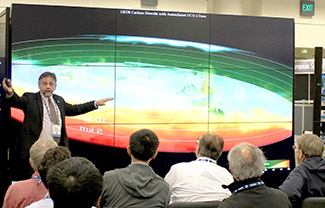 Steven Pawson's two Hyperwall talks provided overviews of the broad spectrum of NASA satellite data that are currently used in GMAO's carbon modeling efforts, highlighting how OCO-2 has been collecting dense atmospheric CO2 data that fills long-standing spatial and temporal gaps in the existing ground-based observation network.
Steven Pawson's two Hyperwall talks provided overviews of the broad spectrum of NASA satellite data that are currently used in GMAO's carbon modeling efforts, highlighting how OCO-2 has been collecting dense atmospheric CO2 data that fills long-standing spatial and temporal gaps in the existing ground-based observation network.
On Wednesday Brad Weir presented the GEOS-Carb modeling and assimilation system development effort at GMAO, which has produced the most complete and highest resolution pictures of global CO2 concentration distributions by assimilating CO2 data from OCO-2 and the Japanese Greenhouse gas Observing SATellite (GOSAT). Initial CO2 fields obtained from these assimilations were presented and compared with ground-based observations. Meanwhile, in her oral presentation on Tuesday, Eunjee Lee presented complementary work looking at series of sensitivity experiments performed using the catchment CN model, a land component of the GEOS-5 AGCM, in order to investigate the impact of temporal variability in atmospheric CO2 forcing (from daily to interannual timescales) on CO2 fluxes at the Earth's surface. 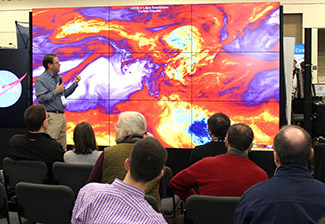
In addition to the previous oral presentations, Abhishek Chatterjee presented a poster entitled “Reconciling bottom-up and top-down carbon flux estimates using NASA's GEOS-Carb monitoring System” based on work with fellow GMAO colleagues Lesley Ott, Watson Gregg, Tomohiro Oda, Cecile Rousseaux, and Brad Weir. Mohar Chattopadhya's Tuesday poster presented a unique application of OCO-2 retrievals to help constrain surface pressure distributions in regions where measurements are sparse, such as over the oceans. Meanwhile, Tomohiro Oda's poster presentation on Friday presented a new satellite-based method for improving the spatial representativeness of human CO2 emissions, for use in high-resolution atmospheric CO2 transport simulations at the urban scale. His work confirmed that the new emissions products significantly improved the performance of the high-resolution simulations
Data Assimilation and Reanalysis
Tuesday's morning session on “Data Assimilation and Applications to Inverse Modeling of Atmospheric Composition” featured two oral presentations by GMAO scientists Ron Gelaro and Nikki Privé. Gelaro opened up the session with an overview of the current status and challenges of atmospheric data assimilation, concluding with a look forward to future uses of coupled data assimilation to help improve forecast skill. Meanwhile, Privé followed an introduction to Observing System Simulation Experiments (OSSEs) by Robert Atlas with a focus on how OSSEs provide an elegant framework for directly calculating analysis and background errors and the impact of observations on analysis quality and forecasts. 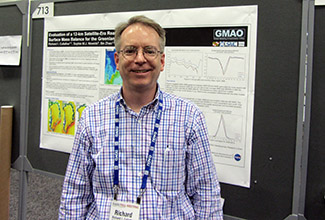
On Wednesday afternoon Michael Bosilovich gave an oral presentation entitled “Evaluating the effect of observing systems on MERRA-2 water and energy cycles.” Bosilovich discussed how changes in observations can potentially negatively impact reanalyses time series, pointing to recent examples of how changes in ocean surface wind observations have affected surface evaporation time series in MERRA-2. Michael's work on the water and energy cycles was complemented by a poster presentation given by Richard Cullather entitled the “Evaluation of a 12-km Satellite-Era Reanalysis of Surface Mass Balance for the Greenland Ice Sheet.” Cullather used MERRA-2 to examine the spatial and temporal variability of surface melt over the Greenland Ice Sheet, showing that the recent contribution to associated sea level changes are strongly driven by surface processes including melt and runoff.
Recent Atmospheric Circulation Anomalies: The 2015/2016 El Niño and Anomalous QBO
Several exciting atmospheric circulation events have occurred this past year. Most noticeably, the 2015/2016 El Niño pattern in the Pacific Ocean has become one of the most powerful on record. In an invited oral presentation on Monday, Yehui Chang presented “A Review of 2015-2016 El Niño Prediction and its Little Influence on Drought-Stricken California,” focusing on possible impacts of El Niño on drought-stricken California. Chang discussed his findings that, despite robust projections that El Niño would soak California in rain, these expectations fell short and left nearly 90% of the state stuck in a historic drought. On a related note, Robin Kovach presented on Thursday her assessment of ENSO Prediction in the NASA GMAO GEOS-5 Seasonal Forecasting System, discussing GEOS-5's capacity to predict global teleconnection patterns in precipitation associated with the recent El Niño event.
Meanwhile, Abhishek Chatterjee's Wednesday's oral presentation on the “Influence of El Niño on atmospheric CO2: Findings from the Orbiting Carbon Observatory-2 (OCO-2) Mission” provided an clear demonstration of additional data constraints that satellite platforms like OCO-2 can provide. In particular, OCO-2 measurements reveal the key role that the tropical Pacific Ocean played this past year in the response of atmospheric CO2 to El Niño.
In addition to recent events in the Pacific, there has been exciting work by GMAO scientists Lawrence Coy and Steven Pawson examining the anomalous Quasi-Biennial Oscillation (QBO) that occurred this year in the tropical middle stratosphere. Presented by Paul Newman (Code 614) this work discussed how during 2015-16 the westerly phase of middle stratospheric winds was displaced anomalously upward, impeding the expected steady downward propagation of the QBO during its westerly phase. The relationship between anomalous Northern Hemisphere Rossby Waves linked to anomalously large tropical horizontal momentum fluxes during this time period was also discussed. Meanwhile, focusing on stratospheric high latitudes, Steven Pawson (on behalf of GMAO scientist Krzysztof Wargan) presented a poster entitled “Polar Processing During the 2015/2016 Arctic Winter in a GEOS Analysis with Stratospheric Chemistry.” This study employed the new configuration of the GEOS Data Assimilation System with the chemistry module STRATCHEM to compute chemical ozone loss in the Arctic lower stratosphere during 2015-2016, showing that the model performance was improved both by the ozone assimilation and the use of STRATCHEM.
Convection and Radiation
Clouds and aerosols contribute some of the largest uncertainties to Earth's radiative budget and several GMAO scientists are hard at work using satellites and models to help constrain some of these uncertainties. On Friday morning Nathan Arnold gave a talk entitled “Feedbacks on Convective Organization in a Non-Rotating Doubly Periodic Version of GEOS-5,” in which he examined the physics of convective organization in GEOS-5 simulations with varying horizontal resolution and domain size. His findings indicate that convection can spontaneously aggregate into a single cluster in small domains, but that it remains dispersed when the domain is large.
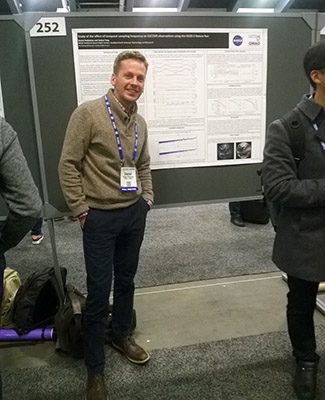 Arnold's talk was complemented by several poster presentations given by GMAO scientists Jyothi Nattala, Peter Norris and Daniel Holdaway. Nattala's Monday morning poster presented a comparison of tropical precipitation composites of cloud variables produced in high resolution climate simulations with those from the recently formulated Aqua-Planet configuration of the NASA GEOS-5 model. Peter Norris also presented a poster titled “Monte Carlo Bayesian Inference on a Statistical Model of Sub-Grid column Moisture Variability using High-Resolution Cloud Observations.” Meanwhile, Daniel Holdaway's poster entitled “Study of the effect of temporal sampling frequency on DSCOVR observations using the GEOS-5 Nature Run” investigated the effect of sampling frequency on the derived Earth's radiation budget and cloud fraction, as would be observed by the Deep Space Climate Observatory (DSCOVR). The effect of temporal resolution on potential DSCOVR observations was assessed by sampling the full GEOS-5 Nature Run data with 1-h to 24-h frequencies, showing that the highest sampling frequencies gave the most information and smallest uncertainty.
Arnold's talk was complemented by several poster presentations given by GMAO scientists Jyothi Nattala, Peter Norris and Daniel Holdaway. Nattala's Monday morning poster presented a comparison of tropical precipitation composites of cloud variables produced in high resolution climate simulations with those from the recently formulated Aqua-Planet configuration of the NASA GEOS-5 model. Peter Norris also presented a poster titled “Monte Carlo Bayesian Inference on a Statistical Model of Sub-Grid column Moisture Variability using High-Resolution Cloud Observations.” Meanwhile, Daniel Holdaway's poster entitled “Study of the effect of temporal sampling frequency on DSCOVR observations using the GEOS-5 Nature Run” investigated the effect of sampling frequency on the derived Earth's radiation budget and cloud fraction, as would be observed by the Deep Space Climate Observatory (DSCOVR). The effect of temporal resolution on potential DSCOVR observations was assessed by sampling the full GEOS-5 Nature Run data with 1-h to 24-h frequencies, showing that the highest sampling frequencies gave the most information and smallest uncertainty.
Finally, Patricia Castellanos presented a poster on Wednesday afternoon based on work with fellow GMAO colleague Arlindo DaSilva entitled “A Neural Network Correction to the Scalar Approximation in Radiative Transfer.” Isaac Moradi's poster on “Radiative Transfer Modelling Activities in Support of NASA GMAO Data Assimilation” summarized recent GMAO activities in support of the Community Radiative Transfer Model, which include generating training coefficients for new instruments as well as developments for assimilating satellite radiances from shortwave infrared channels, among other efforts.
Land-Atmosphere Interactions
In an invited presentation on Tuesday entitled “The Hydrological Behavior of Near-Surface Soil, as Revealed by Collocated SMAP Level-2 Data and Precipitation Gauge Measurements” Randal Koster discussed how SMAP data has been used to innovatively derive US maps of “soil moisture loss function.” In addition to being used to investigate the relationship between soil moisture, precipitation, drainage and evaporation, this metric can contribute significantly to the accuracy of precipitation estimates derived from time series of soil moisture retrievals.
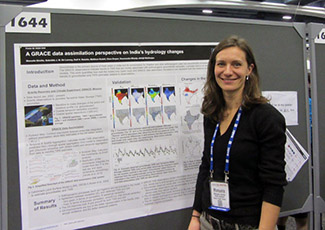 SMAP measurements were also highlighted in Reichle Rolf's Wednesday oral presentation entitled “Assimilation Diagnostics of the SMAP Level 4 (L4_SM) Soil Moisture Product.” Reichle discussed how the L4_SM product provides not only 3-hourly, 9-km resolution, global estimates of surface (0-5 cm) and root zone (0-100 cm) soil moisture but also land surface states and fluxes. Addressing bias correction in SMAP soil moisture assimilation, Jana Kolassa presented recent work using a statistical neural network (retrieval algorithm to calibrate SMAP brightness temperature observations and modeled soil moisture, a technique that permits the retrieval of soil moisture estimates in a model climatology while retaining the spatial and temporal signatures of the satellite observations. Rounding out the representation of GMAO in the hydrology sessions at AGU, Manuela Girotto's work with GRACE observations assimilated within GEOS-5 revealed an exiting and unique way to study recent changes in India's hydrology cycle. She discussed how the consumption of groundwater for irrigation and other anthropogenic uses has unsustainably increased during the past decade in India. Her work reveals that there have been significant changes in various components of the hydrological cycle, not only in surface and root zone soil moisture but also in snow and evaporation.
SMAP measurements were also highlighted in Reichle Rolf's Wednesday oral presentation entitled “Assimilation Diagnostics of the SMAP Level 4 (L4_SM) Soil Moisture Product.” Reichle discussed how the L4_SM product provides not only 3-hourly, 9-km resolution, global estimates of surface (0-5 cm) and root zone (0-100 cm) soil moisture but also land surface states and fluxes. Addressing bias correction in SMAP soil moisture assimilation, Jana Kolassa presented recent work using a statistical neural network (retrieval algorithm to calibrate SMAP brightness temperature observations and modeled soil moisture, a technique that permits the retrieval of soil moisture estimates in a model climatology while retaining the spatial and temporal signatures of the satellite observations. Rounding out the representation of GMAO in the hydrology sessions at AGU, Manuela Girotto's work with GRACE observations assimilated within GEOS-5 revealed an exiting and unique way to study recent changes in India's hydrology cycle. She discussed how the consumption of groundwater for irrigation and other anthropogenic uses has unsustainably increased during the past decade in India. Her work reveals that there have been significant changes in various components of the hydrological cycle, not only in surface and root zone soil moisture but also in snow and evaporation.

